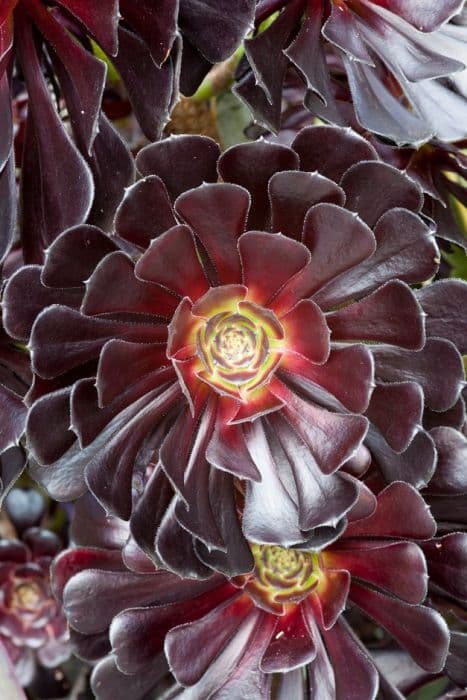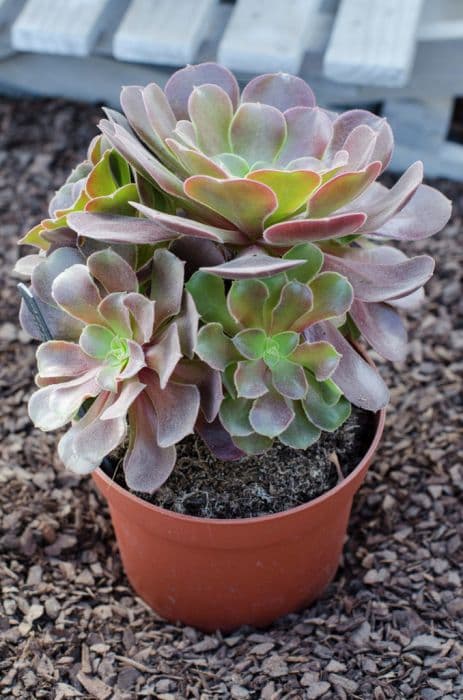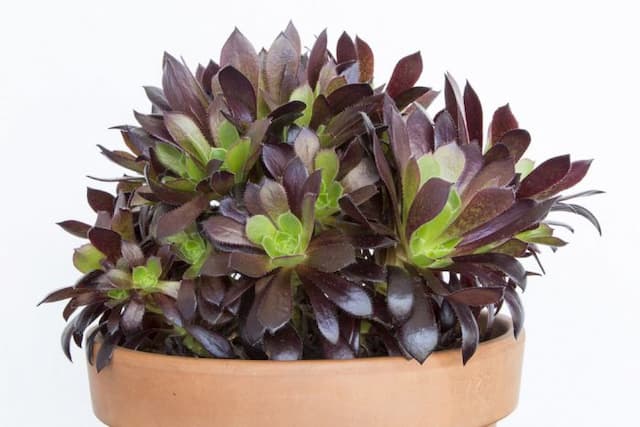Victor Reiter Echeveria Echeveria 'Victor Reiter'

ABOUT
The Echeveria 'Victor Reiter' is a succulent plant known for its striking rosette formation. The leaves of this plant are fleshy and have a spoon-like shape, which often exhibit a stunning powdery-blue or grayish-green color. It's not uncommon for the tips of the leaves to display a hint of pink or red, giving the plant a subtle, colorful accent. The surface of the leaves typically has a waxy, protective coating which helps to retain moisture. Blooms emerging from the Echeveria 'Victor Reiter' are typically shaped like bell-like structures on long, slender stems that rise above the foliage, showcasing shades of pink, orange, or yellow. This plant is well-loved for its decorative, low-maintenance, and drought-tolerant qualities, making it a popular choice for rock gardens, container arrangements, and indoor plant displays.
About this plant
 Names
NamesFamily
Crassulaceae.
Synonyms
Hen And Chicks, Mexican Snowball.
Common names
Echeveria 'Victor Reiter'
 Toxicity
ToxicityTo humans
Echeveria 'Victor Reiter' is generally considered non-toxic to humans. Therefore, if accidentally ingested, it is not expected to cause poisoning or serious health issues. However, as with any plant, individual allergic reactions or sensitivities could occur, so it is advisable to avoid eating any plant not designated for consumption.
To pets
Echeveria 'Victor Reiter', commonly known as Echeveria, is also generally considered non-toxic to pets. Ingesting this plant is unlikely to cause poisoning or serious health concerns in pets such as cats and dogs. Nevertheless, consuming non-food plants can sometimes lead to gastrointestinal upset in animals, so it's best to keep an eye on your pet and consult a veterinarian if any unusual behavior or symptoms are observed after ingestion.
 Characteristics
CharacteristicsLife cycle
Perennials
Foliage type
Evergreen
Color of leaves
Blue-green
Flower color
Red
Height
0.5 feet (15 cm)
Spread
0.5 feet (15 cm)
Plant type
Succulent
Hardiness zones
9
Native area
Mexico
Benefits
 General Benefits
General Benefits- Easy Care: Echeveria Victor Reiter is a low-maintenance plant that is well-suited for those who may not have a lot of time to devote to plant care.
- Decorative Appeal: Its rosette shape and colorful foliage make it an attractive addition to any garden or indoor plant collection.
- Drought Tolerant: This succulent is able to withstand periods of drought, making it a practical choice for water-wise gardens and for people living in arid climates.
- Propagation: It can easily propagate from leaves or offsets, allowing gardeners to create more plants to expand their collection or share with others.
- Non-Toxic: Echeveria plants are generally non-toxic to pets and humans, making them a safe choice for households with animals or children.
- Suitable for Containers: It can thrive in containers, making it versatile for indoor or balcony settings where garden space is limited.
- Seasonal Interest: Some types of Echeveria, including the Victor Reiter, can have colorful blooms that add seasonal interest to their display.
 Medical Properties
Medical PropertiesThis plant is not used for medical purposes.
 Air-purifying Qualities
Air-purifying QualitiesThis plant is not specifically known for air purifying qualities.
 Other Uses
Other Uses- Photography Subject: Echeveria 'Victor Reiter' can be a stunning photography subject for plant photographers, as its rosette shape and vibrant colors create striking images.
- Education Tool: This plant can be used in educational settings to teach about succulent care, propagation techniques, and plant adaptations to arid environments.
- Jewelry Inspiration: The symmetrical rosette pattern of Echeveria 'Victor Reiter' can inspire designs for earrings, necklaces, and other pieces of jewelry.
- Art Projects: Its unique form and texture can be used as inspiration or an actual component in mixed media art projects and botanical illustrations.
- Feng Shui Element: In Feng Shui, Echeveria 'Victor Reiter' can be used to add the wood element to a space, which is believed to bring growth and vitality.
- Theme Gardens: These plants can be used in thematic gardening displays, such as fairy gardens or miniature landscapes, adding aesthetic charm.
- Color Studies: Artists and designers could use the various shades of the Echeveria 'Victor Reiter' as a real-life palette for studying color variations and combinations.
- Event Decoration: The plant can serve as a living decoration for events like weddings or corporate gatherings, fitting well with green or natural themes.
- Props in Theatrical Productions: Echeveria 'Victor Reiter' can be used as a prop in theatrical plays and movies that require a visual representation of flora in desert or exotic locations.
- Sand Terrarium Inhabitant: As a hardy succulent, it can be a fitting inhabitant for sand terrariums, adding structural diversity and requiring minimal maintenance.
Interesting Facts
 Feng Shui
Feng ShuiThe Echeveria is not used in Feng Shui practice.
 Zodiac Sign Compitability
Zodiac Sign CompitabilityThe Echeveria is not used in astrology practice.
 Plant Symbolism
Plant Symbolism- Perseverance and Resilience: Echeveria plants are known for their ability to withstand harsh conditions and bounce back from neglect, symbolizing one's perseverance through challenging situations.
- Timelessness and Longevity: As succulents, Echeverias can live for many years with proper care, representing enduring qualities and a long-lasting presence in one's life.
- Beauty and Balance: Echeverias possess a symmetrical rosette shape, showing the beauty in balance and symmetry in nature and life.
- Adaptability: These plants can adapt to various environments. They symbolize the importance of flexibility and the ability to thrive in a variety of circumstances.
- Fertility and Reproduction: Echeveria produces offsets, or "pups," symbolizing fertility, creativity, and the concept of new growth and reproduction.
 Water
WaterEcheveria, commonly known as Hen and Chicks, should be watered thoroughly, allowing the water to drain out of the pot's bottom and ensuring the soil is completely saturated. During the growing season, typically from spring to early fall, water the plant every 1-2 weeks, allowing the soil to dry out completely between waterings. Reduce watering to once a month during the dormant winter period. It is key to avoid waterlogging as this can lead to root rot. Depending on the plant's size and the pot's volume, use about 8-12 ounces of water during each watering session. Overwatering is the most common mistake, so always check the soil moisture level before adding more water.
 Light
LightHen and Chicks thrive best in a location that receives plenty of bright, indirect sunlight throughout the day. They can tolerate direct morning sunlight but should be protected from the intense afternoon sun which can scorch their leaves. A south or west-facing window with some shading is ideal for indoor plants. Outdoors, they should be placed in a spot where they can enjoy the morning light but are sheltered during the peak hours of the day.
 Temperature
TemperatureHen and Chicks prefer a temperature range between 65°F and 80°F for optimal growth, and should not be exposed to temperatures below 50°F, as they are not frost-tolerant. They can tolerate higher temperatures if provided with adequate ventilation and shading. These plants enjoy a warmer climate and should be protected from extreme cold to prevent damage.
 Pruning
PruningHen and Chicks do not require extensive pruning, but it is beneficial to remove dead or damaged leaves to maintain the plant’s appearance and health. Prune in the spring or early summer when the plant is in its active growth phase. Occasional removal of spent flowers can encourage more compact growth and new offsets.
 Cleaning
CleaningAs needed
 Soil
SoilEcheveria, commonly known as succulent or Hen and Chicks, thrives best in a well-draining soil mix composed of cactus or succulent mix with added perlite or pumice for increased aeration. The ideal pH range for Echeveria should be slightly acidic to slightly alkaline, between 6.0 and 7.5.
 Repotting
RepottingEcheveria should be repotted every two to three years or when it has outgrown its pot to provide fresh soil and encourage growth. During the repotting process, it's a good opportunity to inspect the roots for health.
 Humidity & Misting
Humidity & MistingEcheveria prefers a dry environment with low to moderate humidity. High humidity levels can lead to fungal issues and rot, thus making it unsuitable for this succulent.
 Suitable locations
Suitable locationsIndoor
Place in bright, indirect light and well-draining soil.
Outdoor
Provide full to partial sunlight and protect from frost.
Hardiness zone
9-11 USDA
 Life cycle
Life cycleEcheveria 'Victor Reiter' begins its life cycle as a seed, germinating in warm, well-draining soil with plenty of indirect sunlight, usually in the spring. The seedling stage involves the development of a small rosette, which will gradually grow larger as it enters the juvenile stage, where its succulent leaves thicken and the plant starts to mature. During its adult stage, it will produce offsets, or "pups," around the base, which can be separated and propagated to create new plants. The reproductive maturity is reached when it sends up a flower stalk, usually in the warmer months, blooming with bell-shaped flowers that attract pollinators. After the flowering phase, the mother plant may slowly start to decline, which is a natural part of its lifecycle, though many Echeverias can live and continue to produce offsets for many years. Finally, as senescence occurs, growth slows down, and the plant will eventually die, completing its life cycle.
 Propogation
PropogationPropogation time
Spring-Summer
The Echeveria 'Victor Reiter', commonly known as the Hen and Chicks, is a succulent plant that is comparatively easy to propagate, particularly through leaf cuttings. The best time to propagate is during its active growing season, which is generally spring and early summer. To propagate by leaf cuttings, you will gently twist a healthy leaf from the stem of the mother plant, taking care not to leave any part of the leaf on the stem, as this can impede the rooting process. Allow the leaf to callous over for a few days to prevent rotting. After the end has calloused, place the leaf on well-draining soil, and avoid watering it until roots begin to grow. In a couple of weeks or so, when you notice roots and a new plant starting to form at the base of the leaf, you can begin watering sparingly—roughly an ounce (30 milliliters) of water when the soil has completely dried out. This is the most popular method of propagation for Echeveria 'Victor Reiter', due to its simplicity and effectiveness.









